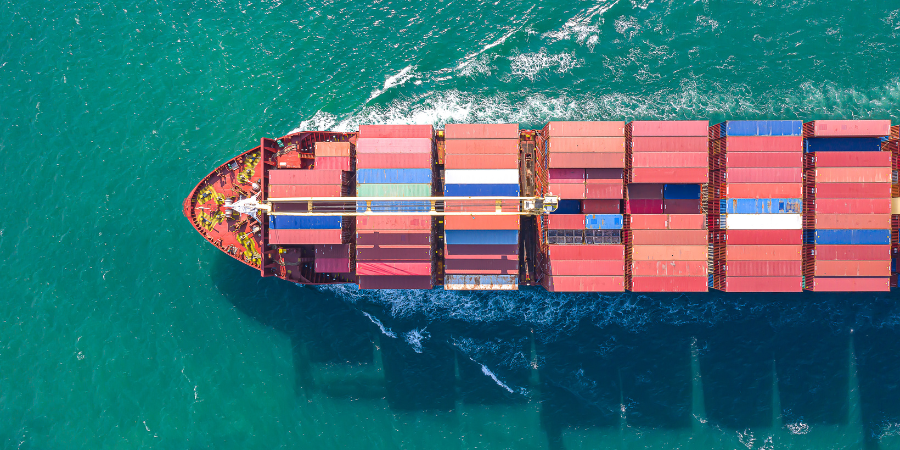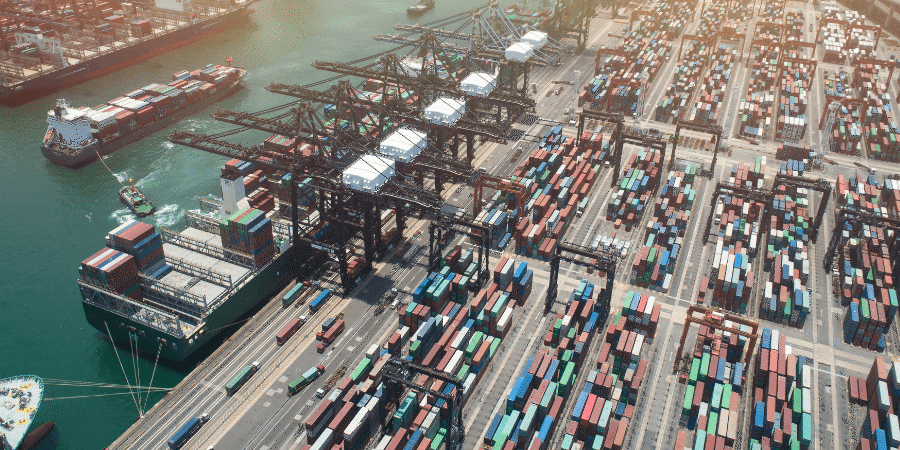How Supply Chain Diversification Can Strengthen Your Operational Resilience
Published on April 01, 2024
Last updated on August 05, 2024
Jump to a section
Broken supply chains have been causing havoc across multiple industries for years now. While some manufacturers have seen the benefit of diversifying their supply chains, issues can still arise, and operational resilience can still be tested.
Global trade hit a record high of $28.5 trillion in 2021, and this has been in part due to the complex web of logistics behind the scenes. Though a streamlined supply chain has helped many companies grow and develop strong partnerships with other businesses, it has led to many issues with supply and demand.
As we embark on a new era of globalisation and continue to build supply chains and markets on a global skill, the need for operational resilience will only grow. Any companies looking for global supply chains should look to build resilience protocols as they evolve.
The impact of COVID-19 on supply chains
The global pandemic caused greater disruption than anyone could have predicted. One survey from Ernst & Young LLP spoke to 200 senior-level supply chain executives and examined the impact COVID-19 had on supplies across late 2020 and 2022.
The survey found that only 2% of respondents were fully prepared for the pandemic. 57% reported a serious disruption to their companies, while 72% had some form of negative effect arising.
The survey was also conducted across multiple industries, including life sciences, education, and more. However, all automotive and 97% of industrial product respondents reported a negative effect from the pandemic.
As a result, supply chain visibility has been a priority since late 2020, but is still very much a work in progress.
Why should you diversify your supply chain?
With visibility and a need for diversification across logistics providers and networks, many companies are choosing to switch from a single-supplier linear chain to an integrated network with a diverse range of sources.
Though the pandemic has been the greatest disruptor in the past decade, geopolitical events like the war in Ukraine and continuing issues in the Suez Canal and natural disasters like hurricanes and wildfires continue to wreak havoc on supply chains. Even very recently, the collapse of the Francis Scott Key Bridge near Baltimore in the USA is due to have a small effect on global supply chains even though the Port of Baltimore is not a major player in world shipping destinations.
In theory, diversification should at least halt some of the issues we typically see with supply chain disruptions. Rather than collect raw materials through a single supplier, many manufacturers choose to have one primary supplier and then others that they can also pull from should their initial link run into issues. This will then allow service to remain as consistent as possible.

Key challenges of supply chain diversification
Though diversification does seem like an easy answer to supply chain risks, it is vital to maintain operational resilience alongside diversifying efforts. Supply chain diversification can bring benefits to a business. Still, it also raises some challenges that need to be addressed if a company wishes to maintain a competitive advantage over others.
Higher costs
When drawing materials from multiple suppliers, inevitably costs can also increase. Many of the smaller costs that can be mitigated through bulk ordering through one supplier will now need to be paid individually to each supplier.
New skills
Choosing to diversify supplier chains can often mean looking at new suppliers in emerging markets. Though this can offer great investment, it does mean that supplier infrastructure needs to be created. This can require companies to invest in the supplier base to ensure that the chain will not fail at this early stage.
Additional risks
Simply adding multiple chains does not immediately solve the issue at hand. Though supply chain diversification will reduce the strain on a potential backlog, each new link will have the potential for partial disruptions.
Slow investment
Setting up new supply chains will never be a quick decision. It takes many resources and a substantial amount of time to create both new supply strategies and the actual logistical network needed to transport materials from A to B.
Changing manufacturing operations is a slow and steady process that aims to deliver value over time – and that should not be rushed. 11% of respondents to a 2020 McKinsey survey noted that smart investments were required in this area, not simply pouring money into

Benefits of supply chain resilience
While challenges will arise when setting up supply chain diversification, when done correctly, the benefits should outweigh the challenges it presents. Typically, a robust supply chain management system will provide resilience against disruptions, in addition to the following benefits.
Improved risk management
Naturally, a business will have to place stronger risk management controls in place. Supply chain operations frequently represent areas prone to risk and loss. By choosing to actively create visibility across all areas of this key network, businesses can optimise and react to processes in real time. This then allows them to mitigate risks whenever they begin to arise.
Enhanced business continuity
The main issue with supply chain disruption is that it halts operations and prevents businesses from successfully fulfilling orders. Supply chain diversification ensures that supplies can always be accessed from some location, and this allows business to continue as normal. Even if disaster plagues some countries on a manufacturer's supply roster, the business themselves will be able to continue as they can, in theory, source materials from another lead.
Increased productivity
Creating a strong base of resilient supply chain management feeds into greater productivity on production lines. With fewer questions as to when supplies will arrive, the estimation time for shipments will be more accurate, and productivity will increase as orders are fulfilled on time and without blockages. In fact, a 2020 report from Bain and Company said investments into supply chain resilience resulted in improvements to plant output of 15-20%.
Strengthened relationships with suppliers
By diversifying supply chains, companies have the opportunity to build strong relationships with a wide range of suppliers. This can ultimately lead to the creation of new business deals and contracts that otherwise might have been unavailable. It can also alleviate some of the pressure on suppliers as they know that they can still expect returning customers even if they cannot fulfil one particular order.
Sustainable growth
Minimised risk and improved productivity result in real and sustainable growth for the company. The 2020 Bain and Company report also stated that companies with strong resilience in their supply chains could decrease the time spent in the product development cycle by up to 60%, while also improving customer satisfaction by up to 30%.

6 strategies for greater resilience in the supply chain
Creating supply chain resilience should be built into any strategy introduced to a company's operations. Though many factors could decide the route an organisation takes towards creating this resilience, these are six strategies that might prove to be beneficial.
1. Inventory and capacity buffers
One of the simplest ways to enhance supply chain resilience is through buffer capacity. This can be through underutilised production facilities or inventory in excess of requirements typically needed for safety stock. Though this is a simple option, it is also one of the most expensive.
Buffers are, therefore, usually used in the short-term, such as being used for surge capacity during new product launches or expansion into new markets.
2. 'China Plus One'
China has been a major supplier to countries all over the world. However, ongoing diplomatic and trade issues can sometimes cause the supply chain to become fractured. For this reason, many manufacturers have chosen to invest in the 'China Plus One' strategy.
Though they maintain their connections to their Chinese business partners, they also seek new contracts in other countries such as India or Mexico. This allows them to then diversify and avoid intensifying disruptions.
3. Multisourcing
Following natural disasters across Asia in 2011, inexpensive but important components became in short supply in the automotive industry. As a result, multisourcing rose as a popular strategy to mitigate disruptions caused by similar risks in the future.
This strategy requires companies to know their supplier networks extremely well. They have to categorise suppliers by both spending and revenue impact. Most companies will face two options: (1.) to either work with multiple suppliers or (2.) choose a sole supplier who can offer goods from multiple locations rather than one centralised one.
4. Near-shoring
Though many companies want to sell on a global level, they don't always want to rely on full global supply chains to receive their materials. Near-shoring requires companies to look for regional or local suppliers.
Though this can be more expensive than the prices and deals offered by suppliers across the world, ultimately it gives manufacturers more control over their inventory. With supplies closer to their plants, they can more effectively shorten cycle times for their finished products.
5. Harmonisation
Harmonisation across platforms, products, or plants can all lead to a seamless network that allows products to move easily and with little risk.
It is common for big manufacturers to standardise components across their product ranges. This is not often visible or even important to the final customers, but it is massively beneficial to businesses that might offer multiple similar products. For example, an electronics manufacturer might commit to a certain type of microprocessing chip for all of their products as it allows them to place a higher volume order while producing all of their products to a high standard.
6. Ecosystem partnerships
The global pandemic taught key lessons across business and manufacturing, with one of those being that a diversified approach to supply chains would be the way forward. However, the need for collaboration is as strong as ever.
What we typically now see is companies developing strong collaborative relationships with other similar businesses in regions they wish to target. Using external manufacturers in this way can aid with moving products around efficiently and can also help companies expand into a new region.

Maintain operational resilience with C2
Supply chain diversification is incredibly important for any business, but it forms just one part of an overall operational resilience strategy. Though manufacturers need to have good control over their supply chain resiliency, they should also strive for an overview across their entire operations if they wish to maintain deadlines and profitability.
In the modern world of business, organisations can face risk from other factors such as cybersecurity and disasters and disruptions to more than just supply chains. The global pandemic has shown, if anything, how vastly under-prepared many organisations are when it comes to maintaining critical supplies and pursuing an optimal sourcing strategy. If a competitive advantage is to be maintained, something needs to change.
C2 Meridian gives companies the control needed for this full overview of all potential risks and the factors required for seamless business continuity in the event of disruption. Our system is designed to fit your company's needs, whether they are routed in maintaining diversification with your suppliers or implementing more resilience across your business as a whole.
Book a demo with C2 today and find out how we can help you better understand your business continuity needs, whatever they might be.
Written by Lisa McStay
Chief Operating Officer at Continuity2
As a proud COO of Continuity2, Lisa strives to provide intuitive and innovative solutions for the Business Resilience market and reshape the industry as we know it today. Lisa has been in the industry for over 10+ years, helping clients achieve their Business Continuity and Resilience objectives for continuous growth and success.


Written by Lisa McStay
Chief Operating Officer at Continuity2
As a proud COO of Continuity2, Lisa strives to provide intuitive and innovative solutions for the Business Resilience market and reshape the industry as we know it today. Lisa has been in the industry for over 10+ years, helping clients achieve their Business Continuity and Resilience objectives for continuous growth and success.